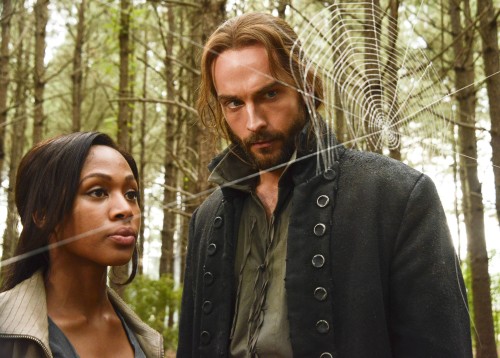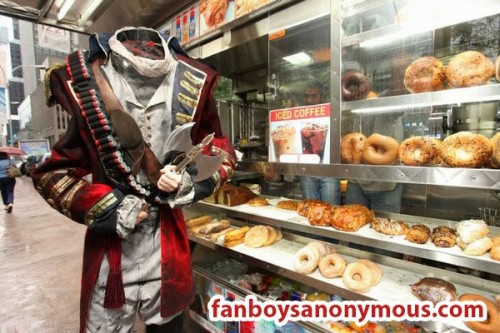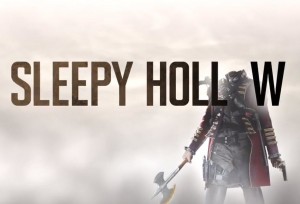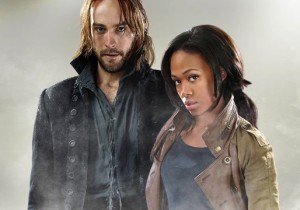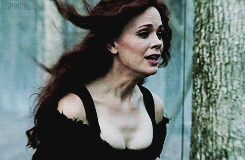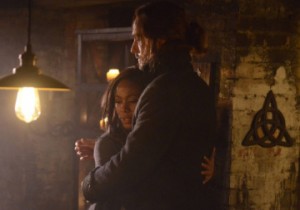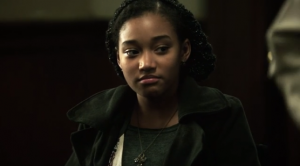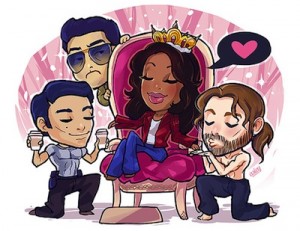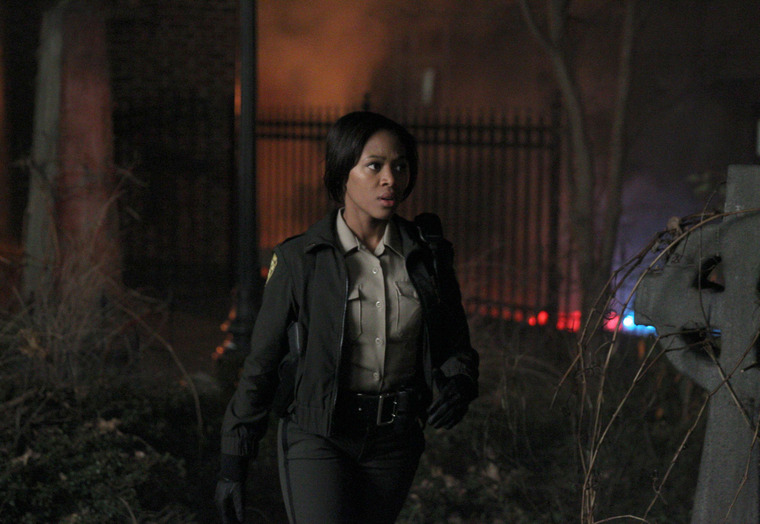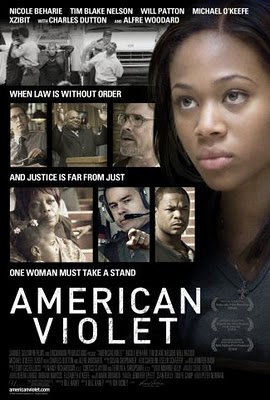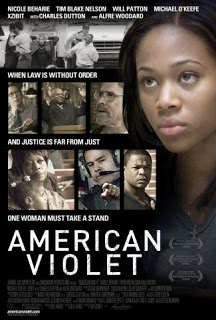This is a guest post by Giselle Defares.
Will FOX be able to save Sleepy Hollow? That was the question that bothered critics and fans alike these past nine months. Not since NBC’s Heroes has a show sunk its own ship from season 1 to 2. FOX and TPTB promised to reboot the story and go back to the magic of season 1.
In the wake of the season 3 premiere this has to be said. The bar for Sleep Hollow’s promotion was set very low and they still missed the mark leading up to the premiere on Oct. 1. All the budget on FOX must have gone to the Empire promo but there had to be someone in the PR department who could have thought of utilizing social media to drum up the interest and the show’s scattered fan base (at least earlier than a week before the show starts). It’s ridiculous that Emmy-winner Viola Davis drummed up more buzz for Nicole Beharie in her speech than the PR department has accomplished in three seasons. That is something else.
There were many things that had to be dealt with in the first episode. There was a nine-month time jump, the broken relationship between Ichabod and Abbie, Jenny back on the forefront, the introduction of two new characters, and last but not least: the case of the week.
In the opening we’re directly introduced to the new villain Pandora (Shannyn Sossamon), who captures the Headless Horseman into her box (or in her own words “it’s more of a dowry”) whilst singing a song. By capturing the Headless Horseman, Pandora gave the box “the power of death” and thus she was able to summon the yaoguai. This is a battlefield demon who paralyzes people and feeds on their fear, which ultimately kills them. This was a great move to tie up the storylines of season 2, hand the baton from one villain to another, but leave the door open. Sossamon plays her role well and it’s interesting to note that during one episode she successfully performed more magic than Katrina in two seasons. How’s that for progress?
We find out that Abbie Mills (Nicole Beharie) has moved on with her life and is fully focused on her career. She finished her training with the FBI and is now a working agent under the leadership of her new mentor Mitch Granger (C. Thomas Howell). During their bust of the multi-state drug trafficking ring – with the cheesy name Anaconda- she receives a phone call with news regarding an old friend.
After the loss of his wife Katrina and son Henry in the season finale, Ichabod Crane (Tom Mison) told Abbie that he was going to “clear his head” and then never came back: “I required solitude. Then it became a habit. A deeply regrettable one.” This was a nice touch. He was grieving after all and needed time to find himself again. Ichabod traveled back to Scotland and searched for answers in his family’s tomb. He found a 4,000-year-old tablet marked with Sumerian engravings which translated to “The Legend of Sleepy Hollow.” OK.
Ichabod travelled back to the States and his family heirloom ensured that he got locked up and he has been in the custody of Immigrations and Customs Enforcement for five days before he called Abbie. The reason? He was ashamed and the necklace that Abraham gave Katrina (that contains his soul) lost its power, which means that something is wrong with the Headless Horseman, and they need to find out what it means. (Side note: Team Witness was still in sync during their time apart since they opted for the same haircut.)
The scene of the first demon attack is in a national park. Two men end up dead and the authorities suspect an animal attack. Abbie knows the area and states that it doesn’t have the right kind of predators. It was a nice moment to see the dynamic between the two. Ichabod the believer and Abbie the sceptic working together as a team; both brought their knowledge to the table. Or as Ichabod dramatically states, “Evil has returned to Sleepy Hollow.”
The duo heads back to the archives and there’s a lovely reunion with Jenny Mills (Lyndie Greenwood). Unfortunately, Irving won’t be coming back but Jenny explains what happened to him and hints that she helped him disappear. Jenny now works as a paralegal and is slowly finding her way back into society. She helps Ichabod and Abbie find out what the substance is that they found in the national park. She quips, “I spent years recovering obscure artifacts from all over the world – this is what I do.” Amen.
It wouldn’t be Sleepy Hollow without a historical connection and a flashback. They find out that when Benjamin Franklin wrote about the “red devil” at Bunker Hill, it didn’t refer to the redcoats names but to the yaoguai. In the flashback that follows we find out that it was Betsy Ross (Nikki Reed) who delivered the message to Colonel Prescott and thus turned history at Bunker Hill. While Sossamon fares well in her role, Reed doesn’t really make a lasting impression. In part because she didn’t really have much to do in her scenes. Her foreshadowing with the line “one day you’ll meet someone who make you forget all those manners” was a nice touch. It’s certainly funny that all the female characters of Ichabod’s past – historic icons no less- have been sexified and all have romantic ties with Ichabod. Betsy Ross felt modern, thus out of place and was dressed like a lost extra on the set of Pirates of the Caribbean.
Abbie is pulled back into work mode when the FBI receives a tip on their drug bust. She finds out that aggression and gunpowder attracts the yaoguai. Unfortunately, the yaoguai paralyzes her mentor Granger and slashes his throat. Why does she need to lose her mentors this way? Abbie does fire some shots and injures the yaoguai, which is a surprise to Team Witness since the demon is supposed to be invulnerable. The yaoguai has one weakness: it can be wounded when its eyes flash white in order to steal someone’s fear. Whilst Abbie is focused on the drug ring. Ichabod and Jenny hastily conduct a plan to trap the yaoguai. It seems to go well but in the end it’s Abbie who saves the day.
The episode is definitely miles better than most of season 2, yet there are some things that are hit or miss. There was no need for an Asian drug ring just because Team Witness was dealing with a Chinese demon. Hopefully Betsy Ross will be less bland in the upcoming episodes. The dialogue is sometimes very on the nose. Whilst trying to find out what demon there up against, Ichabod finds a book where it states that the demon looks for fear and it’s a servant not a master, to which Jenny states: “ Meaning that someone summoned it here, someone evil.” Jenny had some other questionable lines such as “ Guns, knives, things that go boom. We’re back in the demon-fighting business and I think we’re going to need them.” Alright, didn’t think of that. By the way, we still don’t know how Ichabod was able to travel to Scotland (and back) and how he made his living in the past year. How Sway? At least he’s entertaining the idea of finding a job.
While the episode wasn’t perfect we can only hope that Sleepy Hollow will pull off what it has planned and at least for the time being there’s no need to dust off the #AbbieMillsDeservesBetter hashtag.
Giselle Defares comments on film, fashion (law) and American pop culture. See her blog here.




